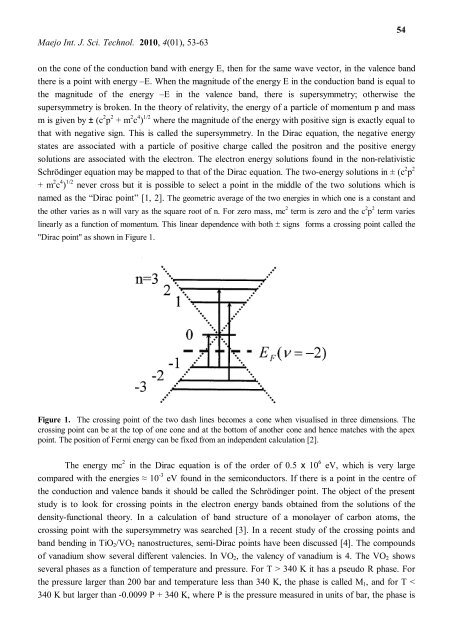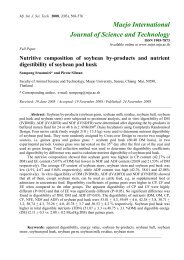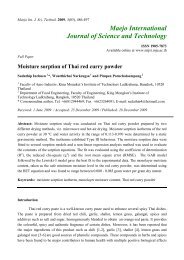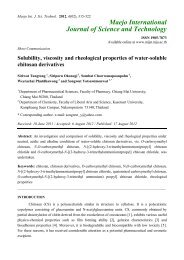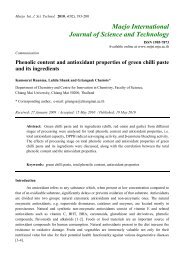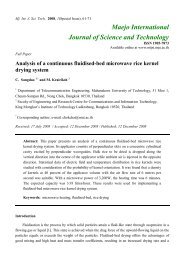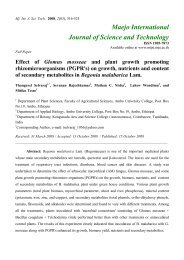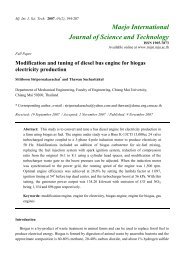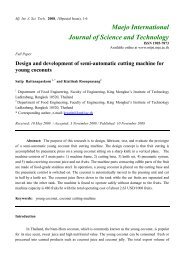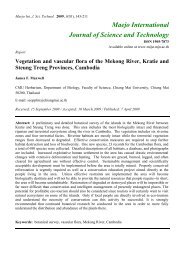Crossing points in the electronic band structure of vanadium oxide
Crossing points in the electronic band structure of vanadium oxide
Crossing points in the electronic band structure of vanadium oxide
Create successful ePaper yourself
Turn your PDF publications into a flip-book with our unique Google optimized e-Paper software.
Maejo Int. J. Sci. Technol. 2010, 4(01), 53-6354on <strong>the</strong> cone <strong>of</strong> <strong>the</strong> conduction <strong>band</strong> with energy E, <strong>the</strong>n for <strong>the</strong> same wave vector, <strong>in</strong> <strong>the</strong> valence <strong>band</strong><strong>the</strong>re is a po<strong>in</strong>t with energy –E. When <strong>the</strong> magnitude <strong>of</strong> <strong>the</strong> energy E <strong>in</strong> <strong>the</strong> conduction <strong>band</strong> is equal to<strong>the</strong> magnitude <strong>of</strong> <strong>the</strong> energy –E <strong>in</strong> <strong>the</strong> valence <strong>band</strong>, <strong>the</strong>re is supersymmetry; o<strong>the</strong>rwise <strong>the</strong>supersymmetry is broken. In <strong>the</strong> <strong>the</strong>ory <strong>of</strong> relativity, <strong>the</strong> energy <strong>of</strong> a particle <strong>of</strong> momentum p and massm is given by ± (c 2 p 2 + m 2 c 4 ) 1/2 where <strong>the</strong> magnitude <strong>of</strong> <strong>the</strong> energy with positive sign is exactly equal tothat with negative sign. This is called <strong>the</strong> supersymmetry. In <strong>the</strong> Dirac equation, <strong>the</strong> negative energystates are associated with a particle <strong>of</strong> positive charge called <strong>the</strong> positron and <strong>the</strong> positive energysolutions are associated with <strong>the</strong> electron. The electron energy solutions found <strong>in</strong> <strong>the</strong> non-relativisticSchröd<strong>in</strong>ger equation may be mapped to that <strong>of</strong> <strong>the</strong> Dirac equation. The two-energy solutions <strong>in</strong> ± (c 2 p 2+ m 2 c 4 ) 1/2 never cross but it is possible to select a po<strong>in</strong>t <strong>in</strong> <strong>the</strong> middle <strong>of</strong> <strong>the</strong> two solutions which isnamed as <strong>the</strong> “Dirac po<strong>in</strong>t” [1, 2]. The geometric average <strong>of</strong> <strong>the</strong> two energies <strong>in</strong> which one is a constant and<strong>the</strong> o<strong>the</strong>r varies as n will vary as <strong>the</strong> square root <strong>of</strong> n. For zero mass, mc 2 term is zero and <strong>the</strong> c 2 p 2 term variesl<strong>in</strong>early as a function <strong>of</strong> momentum. This l<strong>in</strong>ear dependence with both signs forms a cross<strong>in</strong>g po<strong>in</strong>t called <strong>the</strong>"Dirac po<strong>in</strong>t" as shown <strong>in</strong> Figure 1.Figure 1. The cross<strong>in</strong>g po<strong>in</strong>t <strong>of</strong> <strong>the</strong> two dash l<strong>in</strong>es becomes a cone when visualised <strong>in</strong> three dimensions. Thecross<strong>in</strong>g po<strong>in</strong>t can be at <strong>the</strong> top <strong>of</strong> one cone and at <strong>the</strong> bottom <strong>of</strong> ano<strong>the</strong>r cone and hence matches with <strong>the</strong> apexpo<strong>in</strong>t. The position <strong>of</strong> Fermi energy can be fixed from an <strong>in</strong>dependent calculation [2].The energy mc 2 <strong>in</strong> <strong>the</strong> Dirac equation is <strong>of</strong> <strong>the</strong> order <strong>of</strong> 0.5 x 10 6 eV, which is very largecompared with <strong>the</strong> energies ≈ 10 -3 eV found <strong>in</strong> <strong>the</strong> semiconductors. If <strong>the</strong>re is a po<strong>in</strong>t <strong>in</strong> <strong>the</strong> centre <strong>of</strong><strong>the</strong> conduction and valence <strong>band</strong>s it should be called <strong>the</strong> Schröd<strong>in</strong>ger po<strong>in</strong>t. The object <strong>of</strong> <strong>the</strong> presentstudy is to look for cross<strong>in</strong>g <strong>po<strong>in</strong>ts</strong> <strong>in</strong> <strong>the</strong> electron energy <strong>band</strong>s obta<strong>in</strong>ed from <strong>the</strong> solutions <strong>of</strong> <strong>the</strong>density-functional <strong>the</strong>ory. In a calculation <strong>of</strong> <strong>band</strong> <strong>structure</strong> <strong>of</strong> a monolayer <strong>of</strong> carbon atoms, <strong>the</strong>cross<strong>in</strong>g po<strong>in</strong>t with <strong>the</strong> supersymmetry was searched [3]. In a recent study <strong>of</strong> <strong>the</strong> cross<strong>in</strong>g <strong>po<strong>in</strong>ts</strong> and<strong>band</strong> bend<strong>in</strong>g <strong>in</strong> TiO 2 /VO 2 nano<strong>structure</strong>s, semi-Dirac <strong>po<strong>in</strong>ts</strong> have been discussed [4]. The compounds<strong>of</strong> <strong>vanadium</strong> show several different valencies. In VO 2 , <strong>the</strong> valency <strong>of</strong> <strong>vanadium</strong> is 4. The VO 2 showsseveral phases as a function <strong>of</strong> temperature and pressure. For T > 340 K it has a pseudo R phase. For<strong>the</strong> pressure larger than 200 bar and temperature less than 340 K, <strong>the</strong> phase is called M 1 , and for T


